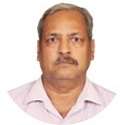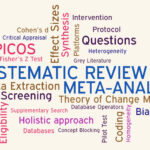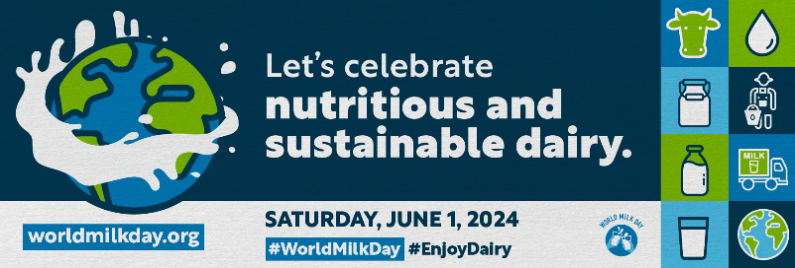Milk is an excellent source of vitamins and minerals, particularly calcium. Therefore, nutritionists recommend that people should consume milk and other dairy products, such as yoghurt and cheese, every day as part of a balanced diet. But milk is not universally accessible to many in the required quantities. In this blog, Mahesh Chander outlines the approaches to celebrate Milk Day so as to popularize milk as a health drink among the masses.
CONTEXT
Since 2001, June 1 is celebrated every year as World Milk Day (WMD) by the Food and Agriculture Organization of the United Nations, to recognize the importance of milk as a global food, and to celebrate the dairy sector. On this day, the benefits of milk and dairy products are actively promoted around the world, including how dairy supports the livelihoods of one billion people. Dairy is an accessible, affordable, and nutrient-dense food, and an essential part of balanced diets across the world. The celebration of Milk Day highlights the importance of milk and dairy products in a healthy diet, and to recognize the contributions of dairy farmers and the dairy industry worldwide. This year’s theme focuses on celebrating the vital role dairy plays in delivering quality nutrition to nourish the world.
Why is Milk important?
Milk offers a range of benefits due to its nutrient content. Milk is a primary source of calcium, crucial for bone health and development, especially in children and adolescents. It also helps maintain bone density and reduces the risk of osteoporosis in older adults. It contains essential vitamins and minerals such as vitamin D, which aids in calcium absorption, vitamin B12 for nerve function and energy production, potassium for heart health, and phosphorus for bone health. Milk is also a hydrating beverage, especially important during physical activity or hot weather. It’s a good source of high-quality protein, containing all essential amino acids necessary for muscle repair, growth, and overall body function. Studies suggest that consuming low-fat or skim milk as part of a balanced diet may support weight management due to its protein content, which helps with satiety. Whole milk contains saturated fats, which in moderation can be part of a balanced diet. However, low-fat or skim milk options provide the same nutrients with reduced fat content. Milk is particularly important for infants and young children as it provides essential nutrients for growth and brain development. A glass of milk with a small amount of flavouring (such as one level teaspoon of chocolate powder) is a healthier option for children than other sugar sweetened drinks such as soft drinks, flavoured waters, fruit drinks and cordials.
Milk is a perfect health drink for all categories of people, except a few who have lactose intolerance. Even those who have been diagnosed with lactose intolerance, can consume lactose-free milk, or standard milk but in lower quantities. Besides contributing to human health and well-being, milk plays a very significant role in the Indian economy, including exports (Box 1).
| Box 1: Milk in India India with 230.58 million tons of annual production (2022-23) is the largest producer of milk in the world, contributing 24% to global milk production. The per capita availability of milk has increased from 303 gram/day in 2013-14 to 444 gram/day in 2021-22, nearly 1.5 times increase. The per capita availability of milk has further increased to 459 grams per day in India during 2022-23 as against the world average of 322 grams per day in 2022 (Food Outlook June 2023). As an industry, it employs more than 80 million households, with the majority being small and marginal farmers as well as the landless. Further, women constitute the major workforce of the dairy sector in India.The sector is an important job provider, especially for women, and plays a leading role in women’s empowerment. The milk industry in India is an extensive network of farmers, dairy cooperatives, and private players. The milk cooperative societies have played a pivotal role in boosting milk production in the country. These have not only made farmers self-sufficient but have also broken the shackles of gender, caste, religion, and community. Dairy Cooperative Societies procured milk per day on average of 589 LKgPD during 2022-23. Dairy cooperatives support dairy farmers by providing technical inputs and various other services such as extension services, veterinary services, Artificial Insemination (AI) services, vaccination, balanced cattle feed, fodder seed, mineral mixture, etc.In addition to milk cooperatives, the private sector is playing a very proactive role in dairying sector with many modern dairies coming up in the private sector. To increase profitability levels and safeguard the industry’s future, Direct to Retail (D2R) and D2C (Direct to Consumer) or DTH (Direct to Home) business models are now gaining momentum in India. Disrupting the industry in recent times, new-age start-ups are changing the milk business very fast where quality and efficiency is being continuously improved.The dairy sector has seen substantial foreign direct investment (FDI) constituting about 40% of FDIs in the Indian food sector. Milk production is growing at the rate of 2% in the world, whereas in India, its growth rate is more than 6%. India exported 67572.99 MT of dairy products (butter, ghee, dairy spreads, cheese, skimmed milk powder) worth USD 284.65 million during 2022-23 to Bangladesh, UAE, Saudi Arab, USA, Bhutan, Sri Lanka, Kuwait, Oman, Singapore, Bahrain and Qatar, etc. |
MILK DAY
Globally, various organizations, including dairy associations, government agencies, and non-profits, conduct awareness campaigns leading up to World Milk Day on June 1. These campaigns aim to educate people on the nutritional benefits of milk and dairy products. Many communities organize events such as milk tasting sessions, dairy farm tours, display of milk products, demonstrations featuring dairy products, and educational workshops on dairy farming practices. Schools often participate in World Milk Day by organizing special activities such as milk-themed art contests, poster and video competitions, nutrition quizzes, and educational talks about the importance of dairy in a balanced diet.
Globally, various organizations, including dairy associations, government agencies, and non-profits, conduct awareness campaigns leading up to World Milk Day on June 1. These campaigns aim to educate people on the nutritional benefits of milk and dairy products. Many communities organize events such as milk tasting sessions, dairy farm tours, display of milk products, demonstrations featuring dairy products, and educational workshops on dairy farming practices. Schools often participate in World Milk Day by organizing special activities such as milk-themed art contests, poster and video competitions, nutrition quizzes, and educational talks about the importance of dairy in a balanced diet.
 Some organizations use WMD as an opportunity to raise funds or collect donations for dairy-related charities or initiatives that support dairy farmers and promote dairy consumption in underprivileged communities. Dairy companies, retailers, and restaurants sometimes collaborate with health organizations or celebrities to promote dairy consumption and offer special discounts or promotions on dairy products on World Milk Day. Newspapers, magazines, TV shows, and online platforms often feature articles, interviews, and stories related to milk, dairy farming, nutrition, and sustainability around WMD. Overall, WMD celebrations aim to raise awareness on the nutritional value of milk, support dairy farmers, promote sustainable dairy practices, and encourage people of all ages to include dairy products in their diets for better health. My institute (ICAR-Indian Veterinary Research Institute) has been organizing various activities in recent years to celebrate WMD (see Box 2) in response to a call from the Global Dairy Platform.
Some organizations use WMD as an opportunity to raise funds or collect donations for dairy-related charities or initiatives that support dairy farmers and promote dairy consumption in underprivileged communities. Dairy companies, retailers, and restaurants sometimes collaborate with health organizations or celebrities to promote dairy consumption and offer special discounts or promotions on dairy products on World Milk Day. Newspapers, magazines, TV shows, and online platforms often feature articles, interviews, and stories related to milk, dairy farming, nutrition, and sustainability around WMD. Overall, WMD celebrations aim to raise awareness on the nutritional value of milk, support dairy farmers, promote sustainable dairy practices, and encourage people of all ages to include dairy products in their diets for better health. My institute (ICAR-Indian Veterinary Research Institute) has been organizing various activities in recent years to celebrate WMD (see Box 2) in response to a call from the Global Dairy Platform.
| Box 2: WMD Activities at ICAR-IVRI In 2020, WMD was celebrated at ICAR-IVRI with the slogan, Drink Milk – Be Healthy to create awareness about milk’s importance as a complete food. Around 600 litres of milk from the ICAR-IVRI Dairy Farm and buttermilk were distributed mainly to women and children, and to orphanages, rehabilitation centres, leprosy ashrams, and slums, etc., through doorstep initiative. The Institute also distributed milk and other products to the Corona Warriors of Uttar Pradesh Police. In 2021, we collaborated with the Global Dairy Platform by registering our WMD activities, such as Students’ Short Video contests. Also, we distributed milk packets to poor households, children and women from weaker sections and farm workers. All these activities were reported on Social Media channels and the IVRI Home page using hashtags #WorldMilkDay and #EnjoyDairy. Furthermore, the Global Dairy Platform included the IVRI WMD photos in its report. |

Any institution can host a campaign (such as a TikTok challenge, Twitter chat, photo contest, videos from a dairy farm, recipe contest, boomerang videos, Snapchat filters, Facebook/Instagram live, influencer campaigns, or song contests) or just join the conversation on social media using #WorldMilkDay & #EnjoyDairy. As per the Global Dairy Platform, any activity counts as a campaign provided the activity has been registered so that it is included in the celebrations. For instance, this year (2024), SMC College of Dairy Science, Anand, Gujarat, will be inviting slogans and cartoons promoting all the theme areas of dairy from existing as well as past (alumni) students of the college. Best three entries in each category will be awarded prizes and will be published in its newsletter. Similarly, in 2020, Agricultural Extension South Asia (AESA) collaborated with the Indian Veterinary Extension Forum (IVEF) to organize a photo contest for the students (Figure 1).
 Social media platforms are used extensively to promote World Milk Day. The Global Dairy Platform has been particularly active in leading the milk promotion campaigns. Using such Hashtags as #WorldMilkDay and #EnjoyDairy, Global Dairy Platform encourages people to share their love for milk and dairy products. There were 1.35 billion Social Media Impressions for the #WorldMilkDay Campaign in 2023. There are mobilizers who voluntarily promote milk campaigns on behalf of the Global Dairy Platform. I have enjoyed being a part of this platform as a Mobilizer since 2018.
Social media platforms are used extensively to promote World Milk Day. The Global Dairy Platform has been particularly active in leading the milk promotion campaigns. Using such Hashtags as #WorldMilkDay and #EnjoyDairy, Global Dairy Platform encourages people to share their love for milk and dairy products. There were 1.35 billion Social Media Impressions for the #WorldMilkDay Campaign in 2023. There are mobilizers who voluntarily promote milk campaigns on behalf of the Global Dairy Platform. I have enjoyed being a part of this platform as a Mobilizer since 2018.
In 2021, Amul conducted a major campaign, on social media, national and regional newspapers/ publications, billboards and TV. In addition, eight Facebook Live sessions were organized with chefs from India, Bangladesh, UAE, and USA who shared milk-based recipes. The Government of India hosted an official campaign, A Glass of Goodness, which shared information on the benefits of dairy products. The network of Krishi Vigyan Kendras working under the Indian Council of Agricultural Research (ICAR) and the Ministry of Agriculture, held an online farmers’ awareness event to mark World Milk Day. The National Dairy Development Board hosted the ‘Milk & Me Competition’ photo contest. The Agricultural and Processed Food Products Export Development Authority (APEDA), organized a webinar in collaboration with the Ministry of Fisheries, Animal Husbandry and Dairying to harness India’s export potential of dairy products. Year after year many organizations around the world organize various activities to promote milk as a health food and source of employment and livelihood for millions.
PROMOTING MILK PRODUCTION AND CONSUMPTION IN INDIA
Through the World Milk Day Celebrations let us further promote milk production and consumption in India. This can be done by taking the following steps.
1. There are huge regional differences in consumption of milk and milk products, though the national average for per capita milk consumption (459 gms) exceeds the ICMR recommendation (300 gms/day). East & Northeast India has very low per capita consumption of milk as also some other states and union territories, such as Goa, Daman & Diu, Delhi, etc.
2. Younger generations are averse to drinking milk, especially in metros. Can we motivate them to prefer milk over soft drinks? Value-added milk products such as flavoured milk, ice creams may attract the younger generations. As milk is a healthier choice, it’s worth encouraging teenagers to drink reduced-fat flavoured milk rather than soft drinks.
3. A lot of milk remains unprocessed due to poor procurement and processing infrastructure in the country. Will it improve? If yes, how long will it take?
4. Milk adulteration is rampant in India. According to a survey (Executive Summary on National Survey on Milk Adulteration, India-2018) conducted by the Food Safety and Standards Authority of India (FSSAI), in India, approximately 68.7% of milk and milk products marketed do not fulfil the required quality criteria.
5. Investments in technologies, such as Bulk Milk Coolers (BMCs), immersion coolers and advanced milk testing kits, would help boost quality of milk as well as remunerative prices to dairy farmers.
6. Extension and Advisory Services (EAS) need to be strengthened for focused attention on promoting good practices for milk production, productivity, quality and consumption among masses across the regions in India, thereby overcoming the regional imbalances currently prevalent.
ROLE OF EXTENSION & ADVISORY SERVICES IN PROMOTING DAIRYING
Extension and Advisory Services (EAS) can play a significant role in promoting dairying by enhancing milk production, milk quality, and milk consumption. It can also help reduce costs for farmers, increase their income, and facilitate organizational structures such as cooperatives and other farmer organizations. The EAS can be tailored to different client groups, including commercial dairy farmers, small, marginal & landless livestock farmers, milk cooperatives, and youth/entrepreneurs. The EAS can provide training programmes on best practices for hygiene and sanitation in milk production. This includes proper milking techniques, regular cleaning of equipment, and the use of sanitary conditions during milk storage and transportation. The EAS can organize programmes to offer technical assistance on animal health, nutrition, and breeding to ensure the production of high-quality milk. This may include guidance on proper feeding regimes, veterinary care, and genetic improvements, as well as implementing quality control systems such as regular milk testing for contaminants and adulterants, ensuring that the milk meets safety standards.
 The EAS can design dairying extension strategies that include consumers too by highlighting the role of milk in providing essential nutrients such as calcium, protein, and vitamins. Until now consumers have been the missing link in EAS schemes and this needs to be fixed. Extension programmes, coupled with extension literature, can create awareness among consumers about the benefits of consuming milk and milk products. This will raise demand for milk and other milk products. The supply side will cater to this need, which in turn will benefit both farmers and consumers. More demand will ensure producers can acquire better prices which will encourage them to boost milk production by improving breeding, feeding, health care and management practices. EAS strategies could be spread by radio and TV programmes for consumers, and social media channels can also play a vital role in spreading nutrition awareness on milk consumption. EAS could also publish extension literature targeting consumers alongside producers. Conducting campaigns to educate the public on the nutritional benefits of milk and dairy products will positively impact the dairy industry. Though it’s a larger policy matter to include milk in school midday meal schemes, yet promoting such milk programmes will ensure children receive adequate nutrition, which can also create a steady demand for milk.
The EAS can design dairying extension strategies that include consumers too by highlighting the role of milk in providing essential nutrients such as calcium, protein, and vitamins. Until now consumers have been the missing link in EAS schemes and this needs to be fixed. Extension programmes, coupled with extension literature, can create awareness among consumers about the benefits of consuming milk and milk products. This will raise demand for milk and other milk products. The supply side will cater to this need, which in turn will benefit both farmers and consumers. More demand will ensure producers can acquire better prices which will encourage them to boost milk production by improving breeding, feeding, health care and management practices. EAS strategies could be spread by radio and TV programmes for consumers, and social media channels can also play a vital role in spreading nutrition awareness on milk consumption. EAS could also publish extension literature targeting consumers alongside producers. Conducting campaigns to educate the public on the nutritional benefits of milk and dairy products will positively impact the dairy industry. Though it’s a larger policy matter to include milk in school midday meal schemes, yet promoting such milk programmes will ensure children receive adequate nutrition, which can also create a steady demand for milk.
The EAS can advise dairy farmers on the development of diversified dairy products (yogurt, cheese, fortified milk) that can cater to different consumer preferences and nutritional needs. Training farmers on cost-effective practices such as efficient feed management, energy-saving technologies, and waste management can be another area for EAS to focus on to reduce the cost of milk production. Another area for EAS to get actively involved is by providing financial literacy programmes to help farmers understand and manage their finances better, including how to access credit and manage loans. EAS can facilitate better market access through improved infrastructure and information systems that connect farmers to markets where they can get better prices for their milk. Encouraging and training farmers on value addition processes, such as converting milk into cheese, butter, and other products that can fetch higher prices is another area where the EAS can intervene.
Organizing farmers into groups – SHGs/FPOs/FPCs – and assisting in the formation and strengthening of milk cooperatives can help in pooling resources, collective bargaining, and achieving economies of scale. Providing training on management of producer groups including cooperative management, leadership, and governance can help ensure these organizations are well-run and sustainable. Here the EAS may find a role to play in helping these groups and cooperatives manage the entire supply chain from production to processing to marketing.
 The importance of EAS in enhancing the productivity and profitability of dairy enterprise is yet to be realized by all the stakeholders involved in dairying. Dairy cooperatives need to strengthen EAS provision so that it can contribute to adoption of new knowledge and enhanced income for dairy farmers. Some of the areas where the EAS can intervene are: providing information on advanced dairy farming technologies and automation to enhance efficiency and production, advising on standards and requirements for entering export markets, encouraging sustainable practices that enhance long term profitability, and environmental responsibility. Organic milk production is an emerging area where the EAS functionaries can improve their capacities to empower dairy farmers by cashing in on new opportunities for increasing their income through price premiums available for organic dairy products.
The importance of EAS in enhancing the productivity and profitability of dairy enterprise is yet to be realized by all the stakeholders involved in dairying. Dairy cooperatives need to strengthen EAS provision so that it can contribute to adoption of new knowledge and enhanced income for dairy farmers. Some of the areas where the EAS can intervene are: providing information on advanced dairy farming technologies and automation to enhance efficiency and production, advising on standards and requirements for entering export markets, encouraging sustainable practices that enhance long term profitability, and environmental responsibility. Organic milk production is an emerging area where the EAS functionaries can improve their capacities to empower dairy farmers by cashing in on new opportunities for increasing their income through price premiums available for organic dairy products.
Since Indian dairying is the mainstay of millions of small-scale farmers, providing basic training on dairy management practices suitable for small-scale operations will be helpful. Facilitating access to microfinance and small loans to help them invest in their farms alongside promoting community-based initiatives such as shared resources and collective marketing could be other areas for EAS intervention. EAS can contribute meaningfully in other areas as well, such as providing training programmes focused on entrepreneurship in the dairy sector, including business planning, financial management, and innovation, offering support for start-ups, including access to incubators and mentorship programmes. They can also help by encouraging the use of technology and digital platforms to innovate and streamline dairy farming processes.
ENDNOTE
Consumers are increasingly demanding a variety of dairy products with more informative labels, value-added ingredients, less sugar, and much more. Tech-backed milk and milk-product delivery platforms are likely to grow even further over the next few years. The massive rise in internet penetration, particularly post COVID-19, has opened up new growth opportunities for digital sales of dairy and milk-based products. EAS can play a multifaceted role in enhancing the dairy sector by focusing on quality production, increasing milk consumption, reducing costs, generating income, and organizing producers. Tailoring these services to different client groups would effectively ensure that the unique needs of each group are met, fostering a more robust and sustainable dairy industry.
Happy Milk Day to all stakeholders engaged in dairying and consumers too!
 Dr Mahesh Chander, is a Principal Scientist (Extension Education), ICAR-Indian Veterinary Research Institute, Izatnagar-243122 (UP), India. He is associated with several National and International Bodies dealing with organic agriculture. He can be reached at (Email: drmahesh.chander@gmail.com)
Dr Mahesh Chander, is a Principal Scientist (Extension Education), ICAR-Indian Veterinary Research Institute, Izatnagar-243122 (UP), India. He is associated with several National and International Bodies dealing with organic agriculture. He can be reached at (Email: drmahesh.chander@gmail.com)









Add Comment